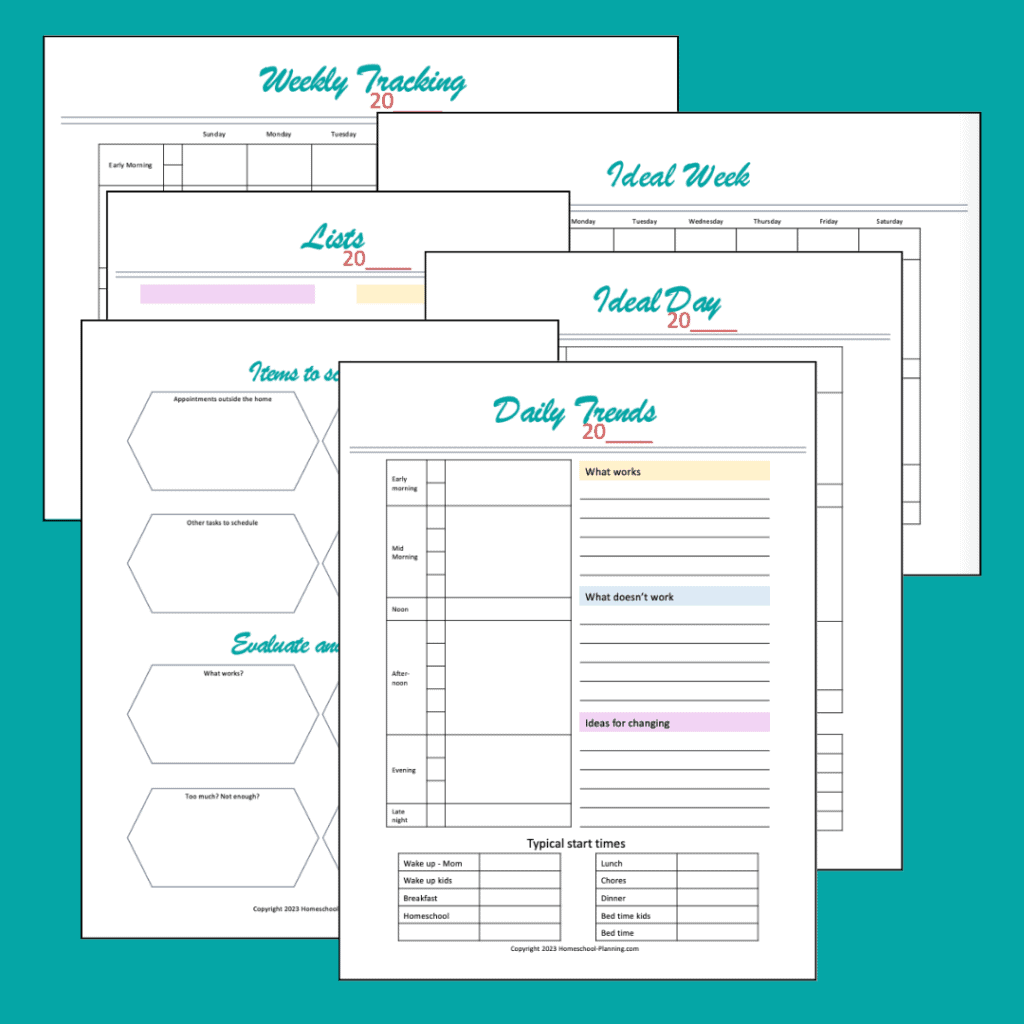Have you been fighting with yourself over setting a schedule and can just never seem to make it work? Maybe you know you need some structure to your day, but struggle with making anything happen that sticks. You need to create your schedule using your natural daily rhythm.
We aren’t all made the same, and trying to fit your family into someone else’s schedule will rarely work. So instead of up-ending your day and trying to be something you’re not, how about you start where you are?
When you find your natural daily rhythm and use that as a basis to set up your new schedule, you not only are more likely to stick with it, but it will help you move through your days with ease.
Keep reading to learn how to find your natural daily rhythm and access it to create the perfect rhythm for your day.

Use your natural daily rhythm to make your schedule
When trying to set up a new schedule or routine for your day, it is helpful to start with what you already do as a basis. In this post, we will discuss my process for discovering your natural daily rhythm. Then use that as a starting point to set up your new rhythm practices for your day.
Be sure to download my free homeschool schedules worksheets to help you through this process! Download here
Here are my 8 steps to create a schedule using your natural daily rhythm.

1. Observe your day
The first step to discovering your natural daily rhythm is to observe your day. Unless you are already very strict in your days, this will take several days. Spend a few days or a week going through what you as a family normally do.
Observe what you do and how you do it. Here are some things to be sure to observe:
- The order things are done
- Times of your day that are more relaxed
- Times that are more active
- When do you have more energy?
- When do you do things together?
- Do you do things apart?
- When do you like to go places?
- Do you tend to stay home at certain times?
- How long does it take to do each task?
- Do you have general start times for things?
- When do you wake up and get to bed?
- When are your meals?
- Does your typical rhythm differ from other family members?
- Do you have set orders for tasks (routines)?

2. Capture what happens
As you are observing your days, what you do, and how you do it, capture all this information and write it down. Write down your typical rhythm and routines, and get the trends on paper.
You may find it helpful to have a running list as you go through your day. Write things down as you go. Or maybe a quick rundown at the end of the day works better for you. You can do this on any sheet of paper, or straight onto a printed weekly schedule.
After you have gathered several days’ worth of information, look at the trends for the week and write those on another list.
The big trends to note:
- Wake up times
- Meal times
- Bed times
- Nap/quiet times
- Going places
- Staying home
- Time for chores
- When you start school or work
- Time for daily routines like getting dressed, cooking, preparing for bed
- Order things are done
- Note the tasks within your routines

3. Listen to good input
When starting something new, it can be helpful to get input from others. Talk with those you trust about ideas for what your day could look like. These could be your spouse, friends, or a mentor. You might even want to talk things over with your kids if they’re old enough – this affects them too.
Be sure you are speaking with those you trust and respect, not just some random person on the internet. Someone who knows you and how you think. But be sure to hold what they say lightly. Even though you trust and respect them, what they think is not what you have to do.
Listening to what works for others can be helpful. But be sure you are also getting advice based on what would work for you. What works for someone else will likely not be right for you. Our schedules shouldn’t be copied and pasted.
This is why it is important to talk with someone who knows you well. If you are easily influenced by the opinion of others, then be careful to not put too much weight on what others think.

4. Trust your instincts
As humans, we have great God-given instincts into what is good for our families. The mama in you will seek to care for your family as top priority. So trust your gut when it comes to your family and your schedule. Your thoughts are important.
So take what you think and feel with at least the same weight as what others suggest. Perhaps even more!
You are the one with your kids all day. You are the one that has to also live with this schedule. So you should get the highest opinion on what goes into it!

5. Create routines
Creating routines for your day can help bring a little order to chaos. Organizing the little things you do, creating a process. You may have already done this out of habit, but encourage routines within your day. Write them down.
Think about what you do when you get ready for your day, write down the order. That’s a routine. Encourage your kids to create these routines as well. Routines help for setting good lasting habits.
You probably already have read about the importance of a bedtime routine for children. The predictability and known steps help them to settle down naturally as they prepare for bed. Sleeping comes easier.
What other routines could be helpful? Here are a few ideas:
- Morning
- Bedtime
- Cooking
- Cleaning
- Chores
- Homeschool
- Work
- Anything else you do in your day
Homeschool routines are a great place to start. Perhaps you decide your homeschool routine starts with breakfast. Then you do your read-alouds, followed by independent work. Simple routine.
The process will help make it happen. After some time, the routine will come easy and become a natural part of your daily rhythm.

6. Practice your rhythm
Once you have established what is your natural daily rhythm for your days and have developed the routines and habits within them, continue to practice this rhythm.
It shouldn’t be too difficult if it truly is what is close to what is natural for you.
Work through what you have to begin with, and practice with your new routines. It won’t be smooth overnight. This is why we practice. It will become easier with time.
Give it a solid week of practice before you make any decisions. It takes time to work on a new thing.

7. Make small changes
As with most things, your schedule never seems to work for long. Just when you get used to it, it stops working. Something happens and changes need to be made.
Or maybe you are trying to do big things with your schedule. Don’t try to do it all at once.
Start with what you already do and make small changes till it works. Add new things slowly. Small changes will stick better than an overhaul.
When the changes feel fairly normal, you can try something else. Changing too much at once will be a shock to everyone and will be difficult to implement.
If you are new to homeschooling, maybe your first focus should just be to start every day. Find a good time in your day when everyone is fresh and can focus. Read a book together. Do a math page. Pick one thing to do until it’s not so hard to do it.
You don’t have to jump straight into 2 hours of sitting at a table. For that matter, you don’t ever have to do that if it doesn’t work for you. This is homeschooling and you have freedom.
But make one change, then add another after a few days. Make the small changes and ease in as everyone adjusts. Eventually, you can set a new rhythm for your day. Just keep it realistic for your family.

8. Evaluate often
Kids will keep you on your toes and just as soon as you have them figured out, they change. This is true when it comes to your daily rhythm and schedule as well! So when you feel like something isn’t working well, evaluate how it could be better and make a small change.
Be sure you give it a good shot before you change things up. Allow a solid week at least. It takes time to adjust.
But if something isn’t working, see if you can figure out where the breakdown happened. Maybe it’s too much change at once. Or the curriculum no longer is a good fit.
Maybe you’re doing too much for too long and getting burnout. Or maybe there’s some boredom and you could change something up for variety.
Perhaps it’s something totally unrelated, and life is just hard right now. It’s ok to step back and relax for a while.
As moms, we are constantly evaluating, so just be sure to remember as you think things through, that it’s ok to change things up whenever you and your family needs.
Natural daily rhythm worksheets
Wanting some worksheets to use as you develop your personalized homeschool schedule? Start tracking your natural daily rhythm today using these scheduling worksheets!
Start with weekly tracking of your natural daily rhythm, then work through the daily trends you find! Follow that by creating your personalized routines, as well as weekly and daily schedules!
Your natural daily rhythm
Setting a schedule using your natural daily rhythm as a starting point can be helpful in creating the most personalized day for your family. Observe what you already do, write it down, and make small changes as you need. This will make your schedule stick easier and help you get a good rhythm going for your day.
What is your natural daily rhythm within your house?

Related posts
Schedules, Routines, and Rhythms: Which is for me?
How to have a flexible homeschool schedule











